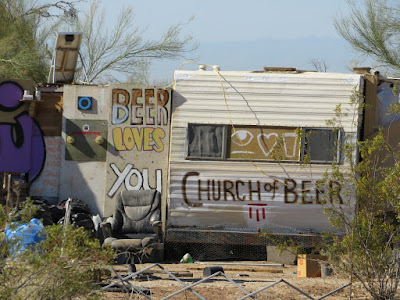Salvation, The Slabs & Deserts...
Today's travels took us to some unique places. What a ride!
We have wanted to visit Leonard Knight's Salvation Mountain since learning about its existence in the middle of the desert.The plaque reads, in part, "Salvation Mountain is Leonard Knight's tribute to God and His gift to the world. Leonard came to Slab City in 1984 (more about that below). Over the following 28 years, he devoted himself to the creation of Salvation Mountain. This folk art monument is Leonard's way of bringing a simple, yet powerful message to the world: God is Love. Leonard has created this brilliant "outsider art" in the midst of the Southern California Desert in Imperial Valley. He crafted this masterpiece with adobe mud and paint. You are welcome to walk up The Yellow Brick Road which leads up from the Sea of Galilee to the cross at the top of Salvation Mountain. You will notice the recurring theme of "LOVE" with the big red heart, the flowers, trees, waterfalls, suns, bluebirds, and other fascinating and colorful objects. Over the years, Leonard learned how to make a lasting monument out of adobe and paint. His first one of concrete fell down in 1986. He said "I guess God wanted me to do it different." So he did. Please remember, the entire Monument is still fragile so please stay on the Yellow Brick Road when climbing up. You are here at your own risk..."
The photos do not do Mr. Knight's work justice. It was recognized by The Folk Art Society of America as a National Folk Art Site. That should tell you something.
On to Slab City...
Before we can share Slab City, we have to tell you about Camp Dunlap.
With the start of World War II in 1939, the United States began the preparation to improve its defense capabilities despite its official policy of "neutrality". The Marine Corps decided they needed a training center for field and anti-aircraft artillery units of Fleet Marine Force, Pacific and that was near enough so that aircraft could take off from an aircraft carrier near San Diego. The deserts close to San Diego area were considered ideal. Long story short, construction of Camp Dunlap ( 631.345 acre) was completed and commissioned on 15 October 1942. Improvements included an estimated 30 buildings in addition to everything else needed for training almost 200,000 troops. After the war, military operations at this location wound down. A skeleton crew was maintained until the base was dismantled in 1956.
The land was then conveyed to the State of California. All of the former Camp Dunlap buildings were removed (except for this guard stand). The remaining slabs were not proposed for removal, hence the name of this enclave of off the grid campers.
There is a ton of googleable information about Slab City, along with video and it even guest starred in the movie Into the Wild.The images really tell the story. I have nothing more to add. Wild indeed!
The next two days are going to be spent doing our own off the grid camping in Anza Borrego.
We were surprised at how much history we discovered here. Vallecito Stage Depot has been designated a Historical Landmark since 1939.
This is a reconstruction (1934) of the Vallecito Stage Station, built in 1852 at the edge of the Great Colorado Desert. It was an important stop on the first official transcontinental route, serving the San Diego-San Antonio ('Jackass') mail line (1857-1859), the Butterfield Overland Stage Line, and the southern emigrant caravans.
We stopped at all the landmark signs. This one, Box Canyon was pretty impressive. The old road, known as the Sonora, Colorado River, or Southern Emigrant Trail and later as the Butterfield Overland Mail Route, traversed Box Canyon just east of here. On January 19, 1847, the Mormon Battalion under the command of Lieutenant Colonel Philip St. G. Cooke, using hand tools, hewed a passage through the rocky walls of the narrow gorge for their wagons and opened the first road into Southern California.
We then delighted in the nature of it all.
This unique lifeform (smaller than a nickel) was found wedged in a rock crack.
Sometimes the beauty was subtle.
“If a flower can flourish in the desert,
you can flourish anywhere.”
- Matshona Dhliwayo
“But in the desert, in the pure clean atmosphere, in the silence –
there you can find yourself.”
- Father Dioscuros













































1 comments:
Oh! A Loggerhead Shrike! I'm keeping an eye out every day in hopes of seeing one here soon. Nice find!
Post a Comment